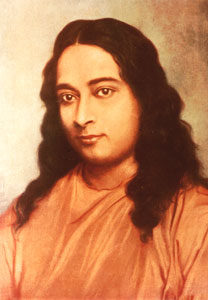

Paramahamsa Yogananda (1893-1952), was an Indian guru who introduced millions of Indians and westerners to the teachings of meditation and Kriya Yoga. He was one of if not, the greatest spiritual leaders of our times and his divine influence continues to be felt today.
Youth and Discipleship
Born in Uttar Pradesh, India, to a devout Hindu family, Yogananda’s younger brother, Sananda, recalls that from a young age, his awareness and experience of the spiritual was far beyond the ordinary.
He sought earnestly for a teacher, and finally met his guru, Swami Sri Yukteswar Giri at the age of 17. In his autobiography, he describes his meeting with Sri Yukteswar as a rekindling of a relationship that had lasted for many lifetimes.
After completing his university studies, the young Yogananda was able to spend time at Yukteswar's ashram in Serampore. In 1915, he took formal vows into the monastic Swami order.
Sri Yukteswar informed Yogananda that he had been sent to him by the great guru of their lineage, Mahavatar Babaji, for a special world purpose of yoga dissemination.
Teaching in America
In 1920, Yogananda went to the United States aboard the ship City of Sparta, as India's delegate to an International Congress of Religious Liberals convening in Boston.
His address to the Congress, on 'The Science of Religion,' was enthusiastically received. For the next several years he lectured and taught across the United States. His discourses taught of the unity of the original teachings of Jesus Christ and the original Yoga taught by Bhagavan Krishna. Thousands came to his lectures.
Visit to India, 1935–1936
In 1935, Yogananda returned to India to visit his guru and to help establish his work there. During this visit, he met with Mahatma Gandhi, and initiated him into the liberating technique of Kriya Yoga.
While in India, Sri Yukteswar gave Yogananda the monastic title of Paramahansa, a title indicating the highest spiritual attainment.
While Yogananda was visiting Calcutta, Yukteswar attained mahasamadhi (final soul liberation) in the town of Puri. It is very difficult to describe the bereavement of a realised yogi who loses the physical company and guidance of his Gurudev.
Yogananda later described a mesmerising and miraculous rendezvous with his beloved Gurudev that took place some days later at the Regent Hotel in Mumbai on the eve of his return to the West. Sri Yukteshwarji materialised in blood and flesh before him and gave a thrilling account of his sojourn in “hiranyaloka.”
Autobiography of a Yogi
After returning to America, Yogananda continued to lecture, write, and establish churches in southern California.
In 1946, Yogananda published his life story, Autobiography of a Yogi. It has since been translated into 45 languages and has sold more than four million copies and counting.
In 1999, it was designated one of the "100 Most Important Spiritual Books of the 20th Century" by a panel of spiritual authors convened by Philip Zaleski and HarperCollins publishers.
Kriya Yoga
Yogananda taught his students the need for direct experience of truth, as opposed to blind belief. He said that "The true basis of religion is not belief, but intuitive experience. Intuition is the soul's power of knowing God. To know what religion is really about, one must know God.
Echoing traditional Hindu teachings, he taught that the entire universe is God's cosmic motion picture, and that individuals are merely actors in the divine play who change roles through reincarnation. He taught that mankind's deep suffering is rooted in identifying too closely with one's current role, rather than with the movie's director, or God.
He taught Kriya Yoga and other meditation practices to help people achieve that understanding, which he called Self-realization.
Death
The last four years of Yogananda’s life were primarily spent in seclusion with some of his inner circle of disciples at his desert ashram in Twentynine Palms, California to finish his writings and to finish revising books, articles and lessons written previously over the years. He gave few interviews and public lectures believing he could do more to reach others with his pen.
In the days leading up to his death, Yogananda began hinting by talking with his disciples that it was time for him to leave the world.
On 7 March 1952, he attended a dinner for the visiting Indian Ambassador to the US, Binay Ranjan Sen, and his wife at the Biltmore Hotel in Los Angeles. At the conclusion of the banquet, Yogananda spoke of India and America, their contributions to world peace and human progress, and their future cooperation, expressing his hope for a "United World" that would combine the best qualities of "efficient America" and "spiritual India."
As Yogananda ended his speech, he read from his poem My India, concluding with the words:
"Where Ganges, woods, Himalayan caves, and men dream God - I am hallowed; my body touched that sod."
As he uttered these words, he lifted his eyes to the Kutastha center (the Ajna Chakra or "spiritual eye") entering mahasamadhi. His body slumped to the floor. The official cause of death was heart failure.
Claims of bodily incorruptibility
As reported in Time Magazine on 4 August 1952, Harry T. Rowe, Los Angeles Mortuary Director of the Forest Lawn Memorial Park in Glendale, California, where Yogananda's body was received, embalmed and interred, wrote in a notarized letter:
The absence of any visual signs of decay in the dead body of Paramahansa Yogananda offers the most extraordinary case in our experience... No physical disintegration was visible in his body even twenty days after death... No indication of mold was visible on his skin, and no visible drying up took place in the bodily tissues. This state of perfect preservation of a body is, so far as we know from mortuary annals, is an unparalleled one... No odor of decay emanated from his body at any time...
